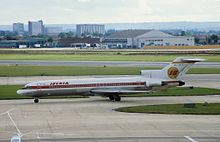Madrid runway disaster
 Overview of Madrid–Barajas Airport, the site of the disaster. | |
| Accident | |
|---|---|
| Date | 7 December 1983 |
| Summary | Runway incursion due to inadequate signs and markings |
| Site | Madrid–Barajas Airport 40°28′11″N 3°33′46″W / 40.46972°N 3.56278°WCoordinates: 40°28′11″N 3°33′46″W / 40.46972°N 3.56278°W |
| Total fatalities | 93 |
| Total injuries | At least 30 (all on the Boeing 727)[1] |
| Total survivors | 42 |
| First aircraft | |
 EC-CFJ, the Boeing 727 involved in the collision, at London in 1981 | |
| Type | Boeing 727-256 |
| Name | Jumila |
| Operator | Iberia |
| Registration | EC-CFJ |
| Flight origin | Madrid–Barajas Airport (MAD/LEMD) |
| Destination | Roma–Fiumicino Airport (FCO/LIRF) |
| Occupants | 93 |
| Passengers | 84 |
| Crew | 9 |
| Fatalities | 51 |
| Injuries | At least 30[1] |
| Survivors | 42 |
| Second aircraft | |
 EC-CGS, the DC-9 involved in the collision, at Mulhouse in 1980 | |
| Type | McDonnell Douglas DC-9-32 |
| Name | Vasco Núñez de Balboa |
| Operator | Aviaco |
| Registration | EC-CGS |
| Flight origin | Madrid–Barajas Airport (MAD/LEMD) |
| Destination | Santander Airport (SDR/LEXJ) |
| Occupants | 42 |
| Passengers | 37 |
| Crew | 5 |
| Fatalities | 42 |
| Injuries | 0 |
| Survivors | 0 |
The Madrid runway disaster was on 7 December 1983 when Iberia Boeing 727 collided with Aviaco McDonnell Douglas DC-9 on the ground at Madrid–Barajas Airport. A departing Iberia Boeing 727 struck an Aviaco McDonnell Douglas DC-9, causing the deaths of 93 passengers and crew.
Crash[]
On 7 December 1983, a Boeing 727 of Iberia (Spain's state airline) registered EC-CFJ, operating Iberia Flight 350, a scheduled flight to Rome's Leonardo da Vinci–Fiumicino Airport, was cleared for take-off from Madrid-Barajas Airport's Runway 01 in conditions of thick fog.[2][3] At the same time, a DC-9 of Aviaco registered EC-CGS, operating Aviaco Flight 134, was taxiing to the end of the same runway for take-off bound for Santander Airport.[4] As the Boeing 727 rolled along the runway, the crew of the DC-9 accidentally made a wrong turn in the fog and taxied their aircraft onto the runway, into the path of the 727. The crew of the 727 saw the DC-9 and attempted to avoid the collision by rotating their aircraft for lift-off, however the 727 had not reached flying speed and its rear fuselage struck the DC-9.[3][4] Both aircraft caught fire and were destroyed; all 42 people on board the DC-9 were killed, while 51 (50 passengers, one crew member) of the 93 on board the Boeing 727 were killed.[2][5] Among those killed were Mexican actress Fanny Cano (she was aboard the Iberia 727) and South African pianist Marc Raubenheimer.[6]
Investigation[]
Investigators found that the Boeing 727 and DC-9 had collided due to the poor visibility at the airport, as well as inadequate signs and markings, which led to the DC-9 entering the runway without clearance as the Boeing 727 was taking off.[2]
See also[]
- 1990 Wayne County Airport runway collision, another fatal runway incursion involving a Boeing 727 and a DC-9.
- 1983 Anchorage runway collision, another December 1983 runway collision involving incorrect taxiing in dense fog.
- Linate Airport disaster, a runway collision in Italy killing 118 people and also involving incorrect taxiing in dense fog.
- Tenerife airport disaster, another collision of two 747 aircraft at a Spanish airport in fog and the worst aircraft accident in history in terms of loss-of-life, with 583 lives lost.
References[]
- ^ a b "Final report of the accident in English" (PDF). Archived (PDF) from the original on 28 December 2012. Retrieved 12 May 2020.
- ^ a b c Ranter, Harro. "ASN Aircraft accident Boeing 727-256 EC-CFJ Madrid-Barajas Airport (MAD)". aviation-safety.net. Aviation Safety Network. Retrieved 11 February 2020.
- ^ a b "Madrid Cleared?", Flight International, 17 December 1983, p. 1582 (online archive version), retrieved 17 April 2012
- ^ a b Ranter, Harro. "ASN Aircraft accident McDonnell Douglas DC-9-32 EC-CGS Madrid-Barajas Airport (MAD)". aviation-safety.net. Aviation Safety Network. Retrieved 11 February 2020.
- ^ "Madrid airport crash death toll set at 92". The Calgary Herald. Reuters. Retrieved 11 February 2020 – via Google News.
- ^ "30 años de la pérdida de José Mª Cagigal en el siniestro de Barajas y del que se libró Ballesteros" [30 years after the loss of José Mª Cagigal in the Barajas incident and from which Ballesteros was spared]. Mundo Deportivo (in Spanish). Retrieved 10 January 2020.
Tal día como hoy de 1983, el aeropuerto de Madrid-Barajas registraba su accidente más mortal hasta el momento, con un total de 93 muertos. La desgracia quiso que entre esas vítimas se encontrase José María Cagigal y dos colaboradores. [English: On this day, as of 1983, the Madrid-Barajas airport recorded its deadliest accident so far, with a total of 93 dead. Misfortune wanted José María Cagigal and two collaborators to be among those victims.]
External links[]
- Final report (Archive)
- Final report (Archive) (in Spanish)
- Iberia Flight 350 at AirDisaster.com[usurped!] (Archive[usurped!])
- Aviaco Flight 134 at AirDisaster.com[usurped!] (Archive[usurped!])
- 1983 in Spain
- Aviation accidents and incidents in 1983
- Runway incursions
- Airliner accidents and incidents caused by pilot error
- Airliner accidents and incidents involving fog
- Aviation accidents and incidents in Spain
- Accidents and incidents involving the Boeing 727
- Accidents and incidents involving the McDonnell Douglas DC-9
- Iberia (airline) accidents and incidents
- Aviaco accidents and incidents
- Adolfo Suárez Madrid–Barajas Airport
- Airliner accidents and incidents involving ground collisions
- December 1983 events in Europe
